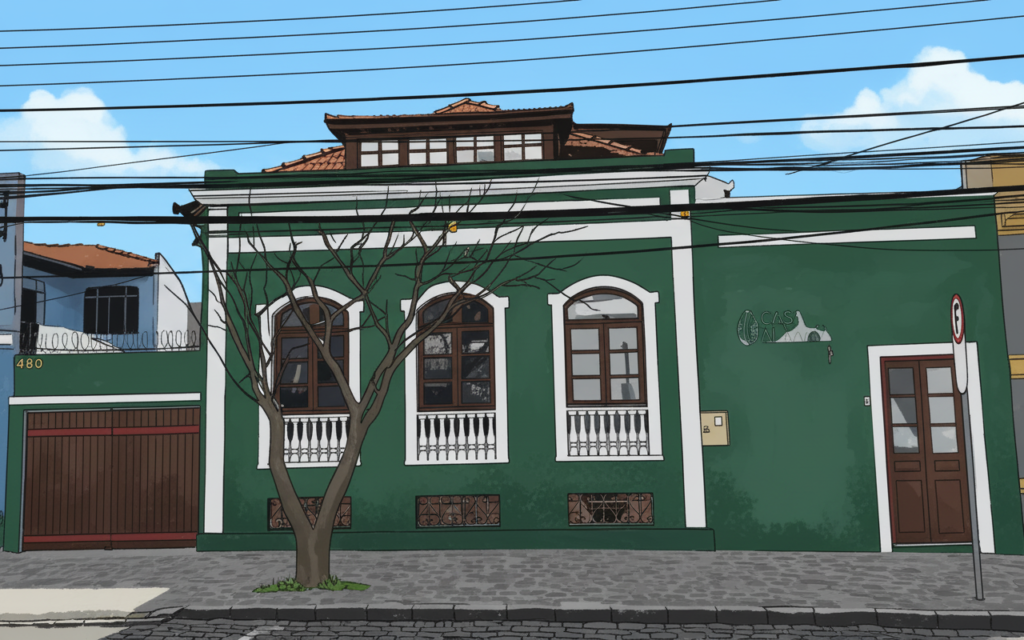Opinion – Djamila Ribeiro: With Casa Aláfia, an Urban Quilombo is Born in the Heart of Curitiba

Originally published in Folha de S. Paulo on August 14, 2025
Brazilian Candomblé is rooted in the worship of orixás—our deified ancestors whose journeys on Earth, long ago, carved paths we still walk and reinterpret today.
It is a philosophy of life anchored in ancestry, transmitted from generation to generation since time immemorial. We honor elders as guardians of memory and wisdom while positioning ourselves as guides and protectors of younger generations.
A significant part of Candomblé practice is devoted to studying and deepening these ancestral paths—technologies used to teach, through the observation of strengths and challenges, how to transcend spiritually and live meaningfully, both individually and collectively.
These paths are known as Odus, and while there are shared principles, each terreiro (temple) may interpret them differently. Odus are often consulted through jogo de búzios (cowrie shell divination), a traditional oracle in Afro-Brazilian religions.
It’s important to highlight that Odus are not about fortune-telling in the popular sense. They offer messages, dilemmas, and questions which, when placed in perspective with one’s life, can lead to deep personal evaluation.
The Odu Ossá, for instance—with nine shells open—might ask how one is honoring feminine power, or signal the need to reconnect with the planet’s magical energy.
Ejiokô, with two shells open, might point to lost lightness in a bitter life, or warn of a naïveté that’s causing harm. The interpretations are endless.
The most widely known study of these paths—also linked to the Ifá tradition, which we’ll explore another time—maps out 256 Odus, concentrated into 16 primary ones.
Each Odu carries its own recommendations, cautions, and meanings, interpreted by a babalorixá or iyalorixá based on their axé-based learning.
So vast is the knowledge surrounding Odus that it could easily fill an entire book series. Scholars such as Mãe Stella de Oxóssi and Agenor Miranda da Rocha, among many others, dedicated their lives to studying them and left significant contributions for future generations.
Among them is an Odu that is celebrated with particular joy: Aláfia. When all 16 shells fall open during a divination, it is almost always a sign of favorable winds—absolute peace, good news, prosperity, and balance. It’s no surprise that “aláfia” became an expression of good fortune, a call for positive thought and action.
With this Odu in mind, I received news from artist Aline Bispo—who has illustrated this column since the beginning—about the opening of Casa Àlàáfíà in Curitiba.
Aline is deeply excited about the initiative, located at 480 Jaime Reis Street. The space is the vision of singer and poet Daniel Montelles and emerges as an urban quilombo in the heart of the city: “A house of Afro-Brazilian culture, aesthetics, and cuisine—a sign that good things are coming. Casa Àlàáfíà resists in diaspora, fiercely carrying the voice of Black people and their matriarchal majesty. We are ready to blacken our relationships, our exchanges… Redesigning models of culture and hospitality in this city, with joy and resistance. A Black space for the community, where hierarchy and reverence for ancestral excellence are our guiding principles.”
The house is rooted in the words of poet Antônio Bispo dos Santos, known as Nego Bispo, who passed away two years ago. Reflecting on the circular worldview of Black, quilombola, and Indigenous peoples, he once said: “We are the beginning, the middle, and the beginning again. We will always exist, smiling in sorrow to welcome joy.”
“Our journeys move us, our ancestry guides us.” Casa Àlàáfíà launched on August 17.
The opening featured afoxé, maracatu, samba, and other cultural expressions. A space by and for Black people, rooted in ancestral knowledge, with each guest invited to wear white in honor of the powerful axé of this beginning.
All I can do is wish the Casa the best of fortunes—and that we all may feel the good path already underway. Aláfia!
An urban quilombo rises in central Curitiba with axé, memory, and resistance.
Content translated with the assistance of artificial intelligence
Related articles
September 14, 2025
Opinion – Djamila Ribeiro: Envy, Resentment and Morality
December 21, 2022
Djamila Ribeiro launches new website
December 21, 2022
Djamila Ribeiro is on the cover of Forbes Life